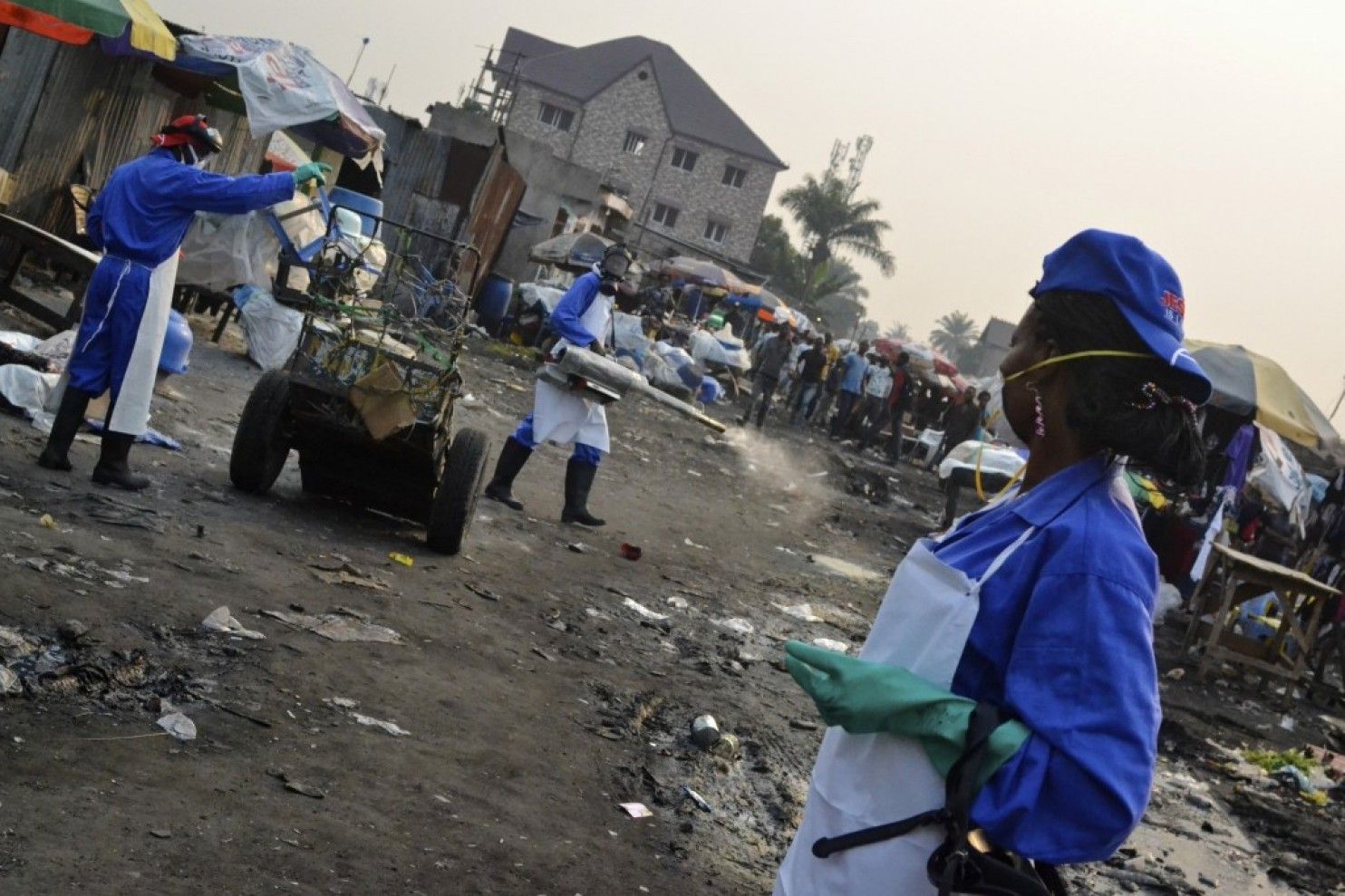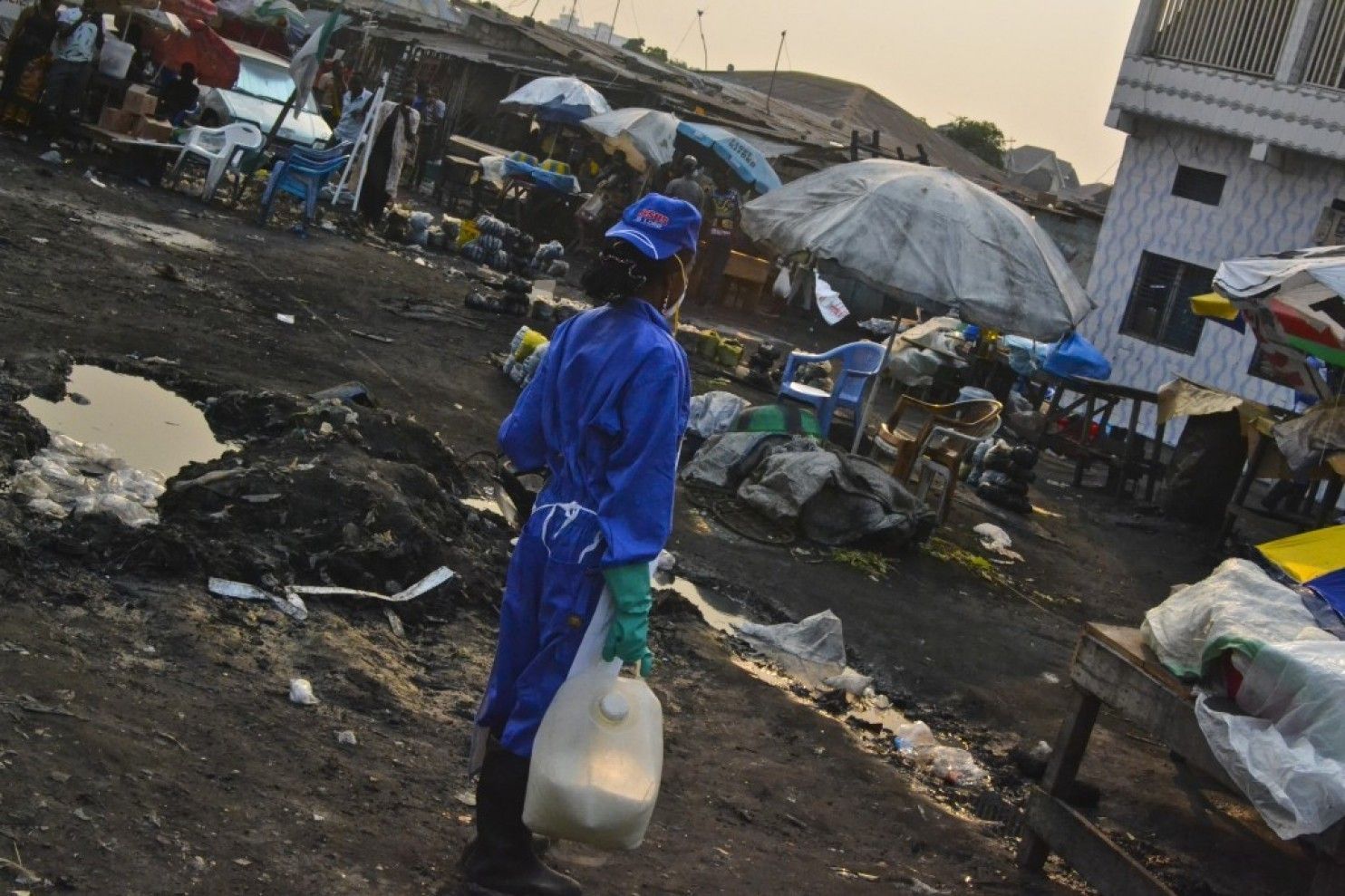Here in Kinshasa they’re using bug spray to repel a pandemic.
At first glance, it looks like a bloody ambush on civilians: dozens in uniform are storming into a bustling marketplace bearing on their shoulders what look like bazookas.
People are screaming, scrambling in every direction, their noses and mouths covered as they drag their children by their hands. Those in uniform chuckle, shaking their heads, smirking; they hiss into megaphones: “We told you we were coming!”
This is vector control in Kinshasa, the capital of the Congo.
The procedure daubs communities in insecticide to fumigate homes and public spaces that breed Aedes aegypti, the mosquito carrying yellow fever. In high quantities, the insecticide is a neurotoxin, and the health workers lament that marketplace invasions seem most petrifying for locals because “there’s nowhere for people to hide.”
The method, a poor alternative to vaccination, is being implemented in the fight against central Africa’s yellow fever outbreak, which has surpassed 6100 suspected cases in Angola and the Congo killing at least 400 without slowing.
After a sluggish and disorderly outbreak response (vanishing vaccines, unrefrigerated vaccines, and ultimately, a global depletion of vaccines), authorities seem to leisurely await the virus’s explosion into Asia and beyond. For months, this bug-spraying protocol has been the only thing keeping aid workers occupied as they wait for 15.5 million more vaccines from higher-ups — vaccines that never seem to come.
Yellow fever is a preventable killer without a cure. The infection shows itself with flu-like symptoms: fever, chills, nausea and vomiting. Most immune systems can fight off the infection over time, but around 15 percent of cases develop jaundice, bleeding from the mouth and nose, and/or eventual organ failure. Aside from support measures like fluid and oxygen, there is no treatment for yellow fever. Up to half of severe cases die. Unlike Zika (or Ebola, and other re-emerging threats), there already exists a yellow fever vaccine — one that’s cheap, lifelong, and highly efficacious. But advancements in the yellow fever approach plateaued almost seven decades ago, when success against the infection suppressed transmission — and concern.
In December 2015, only four factories were producing the yellow fever vaccine globally, each employing an 80-year-old manual production process requiring 18 months from seed virus to agency approval. The entire global stockpile contained just six million vaccines.
The December 2015 yellow fever outbreak arose in the midst of the perfect storm. In the months prior, dropping oil prices for Africa’s second largest crude exporter, Angola, ushered in cuts in public sanitation services; in turn, urban trash buildup created an optimal breeding ground for the mosquitoes.
It arose at the onset of the rainy season, which meant more stagnant water in old tires and stray bottle caps, where mosquitoes breed.
And most of all, it arose while the world was turned the other way, frenzied by the new epidemic, Zika.
When the outbreak sprang up in Angola, response Plan A, we’ll call it, was to use the global vaccine stockpile. According to the WHO, the stockpile is intended to rapidly vaccinate each close contact surrounding a confirmed yellow fever case, thus creating a wall of immunity to smother transmission. If used correctly, six million doses are plenty.
But in this outbreak, the first cases were mistaken for food poisoning from an ethnic restaurant, and by the time Angola alerted international authorities, transmission was out of control.
Plan B, then, was the country’s suggested approach: to blanket-vaccinate. In the early months of 2016, 20 million doses from around the world poured into Angola, then drained in a haphazard mass vaccination campaign. During distribution, at least a million vaccines went missing, and of those accounted for, many were inadequately refrigerated or arrived without proper syringes.
“So, when folks say there are ‘not enough vaccines,’ the question is, not enough for what?” asks Bruce Aylward, ad interim executive director of WHO’s Outbreaks and Health Emergencies Cluster.“Yes, there was enough to identify every transmission chain [early on] and vaccinate around it. But, when countries decide that, rather than do that, let’s just vaccinate this many million … then, well, no, there isn’t enough.”
And because there wasn’t enough, the virus began skulking over the border into Congo. It was clear what would happen if the outbreak reached their unvaccinated capital.
Kinshasa, with 11.5 million people, is twice as big as Luanda, and is particularly globally connected. An outbreak on the outskirts of the urban area would be sad, but one in the midst of Kinshasa’s bustle would be catastrophic. And it was.
So now, it’s on to Plan C: Bug spray.
On the ground, bug spray is keeping teams busy. In addition to marketplace fumigation raids, aid workers are following orders to carry out three other types of vector control: the first is residual spraying, the application of similar insecticide against the interior walls of homes, hospitals, and schools where confirmed cases have traveled while sick.
The rationale is that the A. aegypti mosquito doesn’t fly further than a 100 meter radius from its birthplace, so it often hides in the structure or compound in which it was born — and the one in which it will bite one active case and in turn transmit to a new host.
Secondly, for water reservoirs that cannot be destroyed or covered, vector control workers apply a biological agent called VectoBac. Mosquito larvae in the reservoir eat the bacteria, which then crystallizes inside of them — virtually causing the larvae to explode from the inside out.
And lastly, the teams spend enormous amounts of time doing what experts call “mechanical destruction” — a fancy term for knocking over buckets, iron cans, even littered bottle caps — anything that could serve as potential mosquito breeding grounds. The task is particularly futile in a developing metropolis like Kinshasa, where roads are spattered with garbage and every structure is crowned with hundreds of cratered concrete blocks that pool rainwater.
And at this point in an outbreak, many argue the technique is more of a handy distraction, a way to seem busy in the eyes of the desperate Congolese. Vector control is an important public health development, but all experts concur that when it comes to halting a major outbreak’s transmission, the method is nowhere near as effective as vaccination.
Even Nick Duinslaeger, the director of Doctors Without Borders’ (MSF) water and sanitation program for Kinshasa, has doubts about the operation he is overseeing. “I would like to see some numbers. The [vector control] activities take a lot of effort, a lot of time, a lot of human resources — and I don’t know if it balances out with the impact it has,” Duinslaeger says, noting his views aren’t necessarily those of MSF. “For me personally, the big question remains: what parts of the activity are efficient? And is all of this really helping?”
Complacency is of particular concern when an epidemiological clock is ticking. Thanks to population density, yellow fever outbreaks tend to explode when they reach urban areas. The region’s last major yellow fever outbreak, which began in Nigeria in 1986, infected 116,000 people and killed 24,000 of them — more than twice the number killed in the West African Ebola epidemic. Africa’s urban populations have grown tremendously since the 80s, and thus, so has the virus’s playground.
In this outbreak, soon after yellow fever began spreading through the provinces of Angola, several cases were exported to Kenya and China. The latter is of utmost concern — ripe with A. aegypti mosquitoes, host monkeys, and a perfect climate, Southeast Asia’s lack of yellow fever thus far is enigmatic. When that changes, the disease will be nearly impossible to eradicate.
“There’s no evidence of a [biologically] changing virus, but there’s certainly evidence of a changing world,” says Aylward, referring to the risks that come with increased globalization and particularly international travel. “Many people believe that yellow fever in Asia is really just a matter of time.”
In fact, a yellow fever spark in any of the 100 countries with endemic dengue — also carried by the A. aegypti — could quickly explode. Few of these areas are well vaccinated, including much of central Africa, Southeast Asia, and even the eastern seaboard of Brazil.
If you wrapped a thick piece of yellow caution tape around the equator of a standard-sized classroom globe, you’d have a good sense of the major world regions at risk in this outbreak.
Critics of the WHO are crying déjà vu; they claim the current yellow fever response, though less visible, has been botched to the degree of the response to the West African Ebola epidemic — which killed over 11,000 and took two years to contain. When a WHO emergency committee on yellow fever convened in May, the group declined to deem this yellow fever outbreak a “public health emergency of international concern,” or PHEIC.
Last week, the WHO announced it would meet again in late August or early September to revisit their initial verdict.
In some ways, the Congolese households seem more in tune with the threat’s magnitude than the international authorities. Since the infection lingered on the border, they’ve been aware that vaccination is the foolproof prevention method — and they’ve been begging for vaccines. When vector control teams move down each road, parcel-by-parcel, perforating water containers, residents ask: if you could make the journey here, why couldn’t the vaccines make it with you?
“The main concern is vaccination, now more than ever. Everywhere we go, they are always asking, ‘where is the vaccine? Where is the vaccine?’” says Ir Nobikana Nganabo Esperance, a health promoter employed by the Congo Ministry of Environment. She travels with a vector control team to sensitize locals. “We’re trying to explain to them that it will come eventually. We tell them that this step ‘comes first,’ I guess, and afterward, maybe the government will think about vaccination.”
And yes, they’re thinking about it. Last Wednesday, eight months after the start of the outbreak, a $34 million dollar vaccination effort just began to roll out. The campaign will vaccinate another 15.5 million people — totaling close to 30 million — many of whom will receive only one-fifth of a dose to stretch the limited supply. Fractional doses will require a particularly small syringe, of which there is also a shortage. The massive campaign needs to be completed in less than three weeks to make sure recipients develop immunity by the end of September, when the rainy season will cause mosquito breeding to soar.
"Complacency sets in super fast,” Aylward of WHO admits. “So we’re trying to use this August, this small window, to belt this thing incredibly hard, raise awareness, and manage what could be a substantive international health risk.”
To most, the scope, timing, and manpower required of the undertaking seem unrealistic. In most communities, it remains an ominous waiting game: the Congolese are told to hang tight, to literally kick the bucket — and to dodge response teams with their bazookas full of insecticide.





